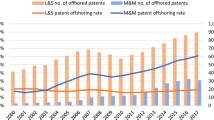Abstract
Within the field of the organisation of science, concerns about how academics generate patents tend to focus on a single set of either national or international patents. The main aim of this research is to study both national and international patenting in order to understand their differences. We have approached this issue from both a historical and an economic perspective, using data from the Spanish National Research Council (CSIC), the largest PRO in Spain. Three periods can be distinguished in the CSIC’s history, according to the political context, namely the dictatorship (1939–1975), the transition to democracy (1976–1986) and democracy (1987-to date). The prevailing legal and institutional framework has marked the way in which patenting by CSIC has evolved in each of these periods. The current situation is one in which there is strong internationalisation of patenting activity, and in this most-recent period we explore trends in some of the economic influences on patenting activity. We conclude that the political and normative context may shape the culture of international patenting at PROs like the CSIC and that increasing technological cooperation has supported this internationalisation. However, very often foreign partners are included in the application in order to extend protection abroad for commercial reasons, so their number may not be a good indicator of inventive activity.
Similar content being viewed by others
References
Azagra-Caro, J. M., Romero-De-Pablos, A. (2006), Patenting at public research organisations: a historical-economic approach, DIME-Universities Working Paper Series, http://uil.dime-eu.org/views/uil_publications
Azagra-Caro, J. M., Yegros-Yegros, A., Archontakis, F. (2006), What do university patent routes indicate at regional level? Scientometrics, 66(1): 219–230.
Carayol, N., Matt, M. (2004), Does research organization influence academic production? Laboratory evidence from a large European university. Research Policy, 33: 1081–1102.
Delgado, L., Elizalde, M. D. (Eds) (2005), España y Estados Unidos en el siglo XX. Madrid: Consejo Superior de Investigaciones Científicas.
Feller, I. (1990), Universities as engines of R&D-based economic growth: They think they can. Research Policy, 19: 335–348.
Martin, B. (2003), The changing social contract for science and the evolution of the university. In: A. Geuna, A. J. Salter, W. E. Steinmueller (Eds), Science and Innovation. Cheltenham: Edward Elgar.
Metlay, G. (2006), Reconsidering renormalization: stability and change in 20th-century views on university patents. Social Studies of Science, 36(4): 565–597.
Mowery, D. C., Sampat, B. N. (2001), University patents and patent policy debates in the USA (1925–1980), Industrial and Corporate Change, 10(3): 781–814.
Pavitt, K. (1998), Do patents reflect the useful research output of universities? Research Evaluation, 7(2): 105–11.
Author information
Authors and Affiliations
Corresponding author
Rights and permissions
About this article
Cite this article
Romero-De-Pablos, A., Azagra-Caro, J.M. Internationalisation of patents by Public Research Organisations from a historical and an economic perspective. Scientometrics 79, 329–340 (2009). https://doi.org/10.1007/s11192-009-0421-3
Received:
Published:
Issue Date:
DOI: https://doi.org/10.1007/s11192-009-0421-3




